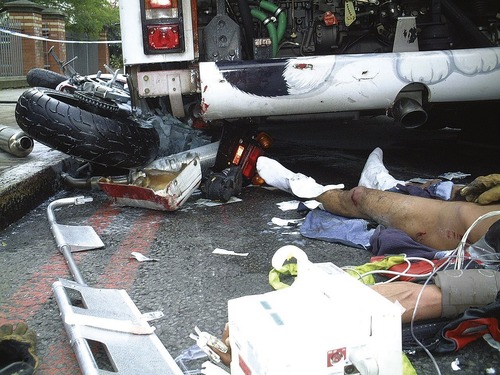CASE 11
 |
Incident
A 24-year-old male motorcyclist has collided with a bus. He was briefly trapped and has burns to his lower limbs. He is conscious but hypotensive (SBP 80 mmHg).
Relevant information
▪ Aircraft: Offline. Rapid response road vehicle available
▪ Ground resources: One land ambulance and crew. Police and Fire & Rescue Services
▪ Retrieval options: General hospital 5 minutes by road. Major trauma hospital 15 minutes by road
▪ Other: Raining
Questions
11.1 What is your pre-hospital plan prior to arrival?
11.2 Comment on the picture of the above scene.
On arrival, the patient is pale and quiet. Initial observations on handover from the paramedic:
A brief clinical examination reveals a clear airway with no respiratory compromise. The abdomen is generally tender. Both legs are externally rotated. There are deep partial thickness burns to both feet. The patient is able to move all four limbs. There is no evidence of long bone fracture or overt haemorrhage.
11.3 Outline your initial assessment and management.
11.4 How will you manage the patient’s hypotension?
Discussion
11.1 Potential hazards should be considered. In the absence of further information, fire should be considered a risk to the PHR team whenever burns are reported. The patient is hypotensive following a significant mechanism of injury. The focus should therefore be on rapid assessment, preservation of blood volume, careful packaging and swift movement to definitive care. Patients with multiple injuries displaying pre-hospital physiological instability are best managed in a major trauma hospital, which is the destination of choice in this instance. A high degree of suspicion should apply to the patient with a significant mechanism of injury regardless of the initial findings.
11.2 The scene has been cordoned. The stability of the bus is unclear. Furthermore, the bus engine cover has been removed and there is evidence of recent use of a fire extinguisher. Clarification should be sought from on-scene senior Fire & Rescue Service personnel regarding scene safety. A motorcycle has come to rest between the underside of the bus and the road kerb. There is significant damage to both the motorcycle and the rear of the bus. The patient lies supine in close proximity to the incident. Initial monitoring, exposure and lower limb wound care has commenced. Both lower limbs are somewhat externally rotated, raising the suspicion of a pelvic ring disruption.
11.3 The initial assessment confirms that the patient is hypotensive. Without evidence of an obvious non-haemorrhagic cause for hypotension, it should be assumed that the patient has an occult haemorrhagic threat. Scene time should be minimised and swift movement to a major trauma hospital is appropriate. To facilitate further safe assessment, packaging and transport, the patient will need to be moved. It is important to remember that the process of pre-hospital packaging is, in itself, a therapeutic process. The brief amount of time taken to cut the clothes properly, stabilise a suspected pelvic fracture, gently perform a partial log roll and scoop the patient into a vacuum mattress for transfer to the ambulance stretcher is time well spent (see Case 8). Local practice will guide the specifics of the packaging process. However, the emphasis should be on gentle handling, early splinting, preservation of blood volume, adequate analgesia and swift transfer.
< div class='tao-gold-member'>
Only gold members can continue reading. Log In or Register to continue
Stay updated, free articles. Join our Telegram channel

Full access? Get Clinical Tree








